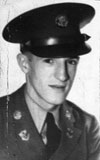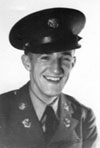 My uncle Henry Majeski was born October 31, 1917 in Philadelphia, Pennsylvania. His sister Genevieve Majeski was my mother and his parents Chester and Frances Majeski were my grandparents. Henry grew up and attended school in the 1920s and 1930s in Philadelphia. In early 1941, as American military forces were building up in anticipation of involvement in World War II, Henry enlisted in the United States Army Air Force.
My uncle Henry Majeski was born October 31, 1917 in Philadelphia, Pennsylvania. His sister Genevieve Majeski was my mother and his parents Chester and Frances Majeski were my grandparents. Henry grew up and attended school in the 1920s and 1930s in Philadelphia. In early 1941, as American military forces were building up in anticipation of involvement in World War II, Henry enlisted in the United States Army Air Force.
He was assigned to the 42nd Bomb Squadron of the 11th Bomb Group (Heavy) when the group was first established at Hickam Field, near Honolulu, Hawaii. Henry was initially an armorer for the squadron, responsible for maintaining and repairing the heavy machine guns on the squadron’s bombers as well as loading the long chains of machine gun ammunition.
The 11th Bomb Group initially was equipped with B-18 bombers but, shortly before the Japanese sneak attack at Pearl Harbor began to be equipped with the then-new B-17 bomber. A flight of new B-17 bombers was inbound to Hickam from California and destined for the 11th Bomb Group when they flew into the middle of the Japanese attack on December 7, 1941.
 Private First Class Majeski survived the attack on Hickam Field and Pearl Harbor. Not long afterward, the 11th Bomb Group deployed to the southwestern Pacific, where Henry saw action at Guadalcanal and at many other islands. By now Henry had been reassigned from being an armorer to being a machine gunner as part of the crew on the B-17s.
Private First Class Majeski survived the attack on Hickam Field and Pearl Harbor. Not long afterward, the 11th Bomb Group deployed to the southwestern Pacific, where Henry saw action at Guadalcanal and at many other islands. By now Henry had been reassigned from being an armorer to being a machine gunner as part of the crew on the B-17s.
In the latter half of 1942 portions of the 11th Bomb Group were detached from offensive bombing missions to fly armed reconnaissance for the Navy, which had no armed reconnaissance aircraft of its own. The Navy’s unarmed reconnaissance aircraft were being rapidly gunned down by Japanese Zero fighters coming up to challenge them.
Initially, this tactic worked well, as the Japanese Zeros which came up found themselves tangling with the heavily armed B-17s instead of the unarmed sitting ducks they’d been used to shooting at. But after awhile the Japanese learned the B-17 had a blind spot from which direction they could attack in relative safety – head on.
 On December 28, 1942 Japanese Zeros swarmed to attack the single B-17E "Ole Sh'asta" 41-2428 in which Henry was flying a reconnaissance mission in the Solomon Islands. The B-17 was shot down and crashed in the water near Choiseul Island, where it sank with the loss of the entire crew.
On December 28, 1942 Japanese Zeros swarmed to attack the single B-17E "Ole Sh'asta" 41-2428 in which Henry was flying a reconnaissance mission in the Solomon Islands. The B-17 was shot down and crashed in the water near Choiseul Island, where it sank with the loss of the entire crew.
Neither the B-17 nor the crew has ever been found and for nearly 65 years now has lain entombed in the warm waters of the southwestern Pacific near the island of Choiseul. Henry and the other members of his crew were memorialized at the American Military Cemetery in Fort Bonifacio near Manila in the Philippines.
Henry was awarded the Silver Star for gallantry in combat, the Air Medal for air combat operations, and the Purple Heart for giving his life for his country. He was a member of America’s Greatest Generation and will always live on in my heart.
Thanks, Uncle Henry.
Contribute
Information
Do you have photos or additional information to add?